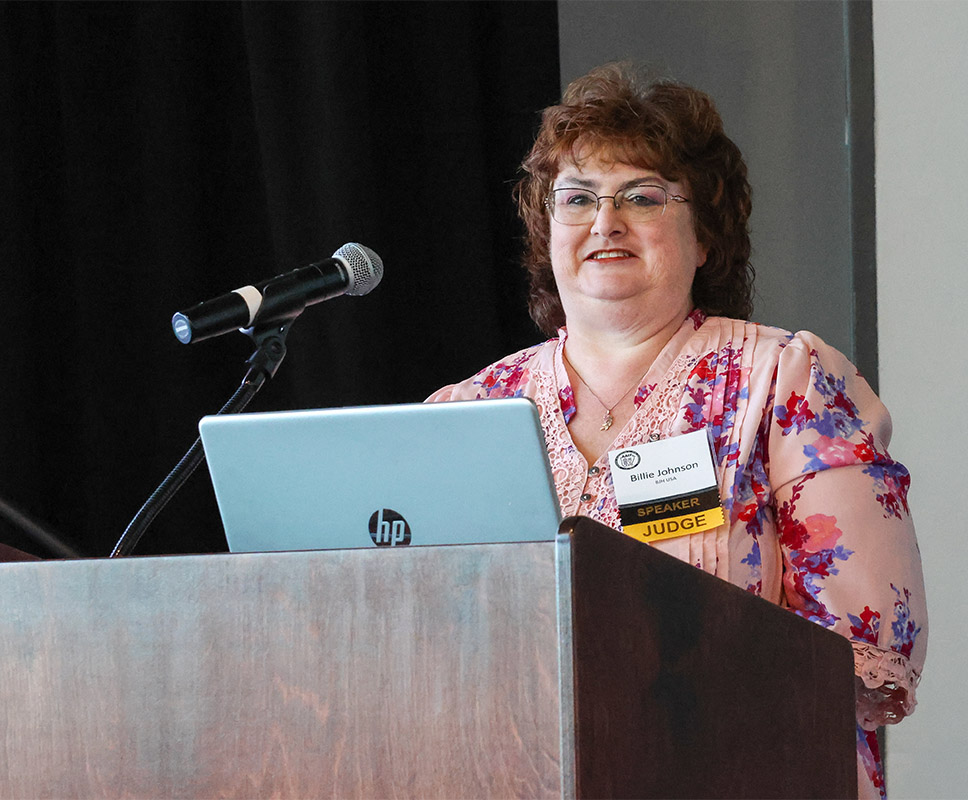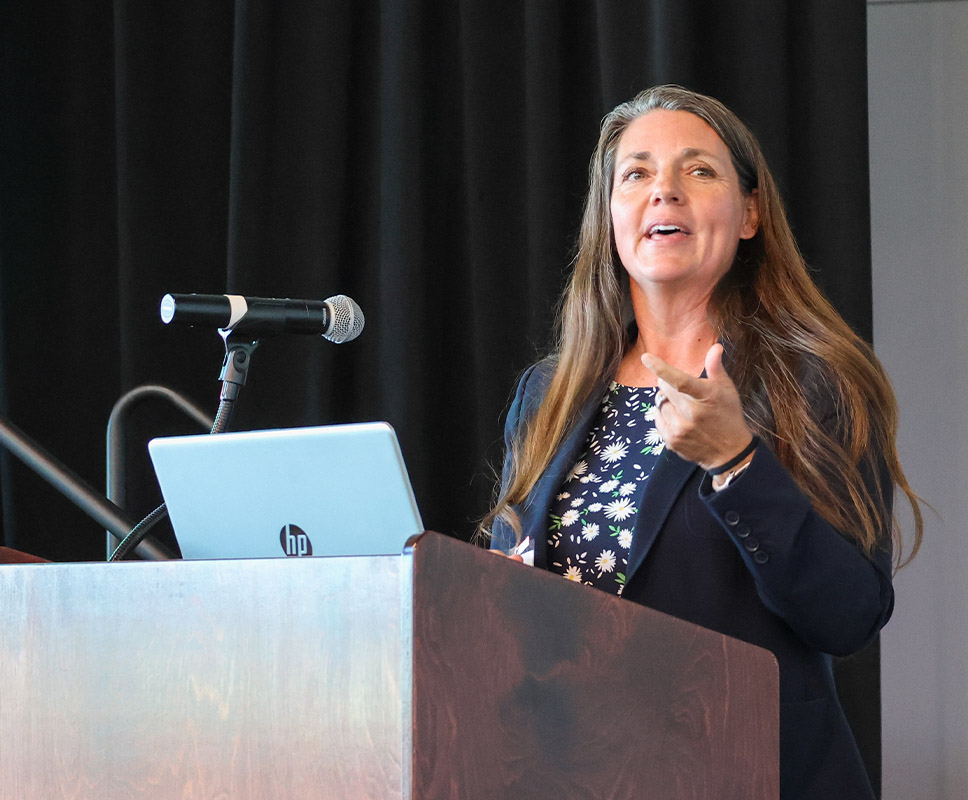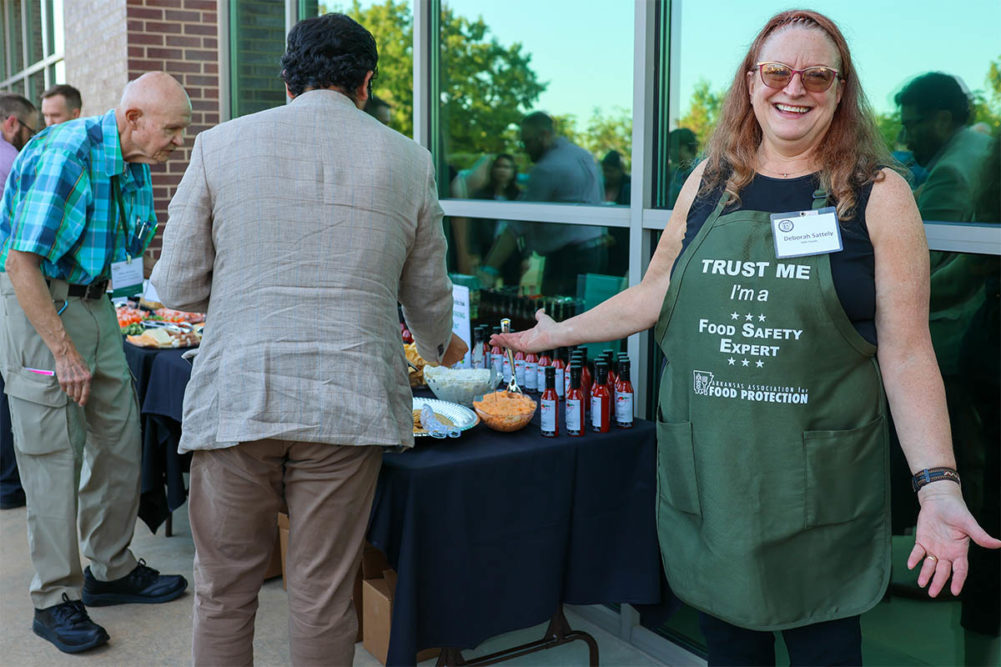FAYETTEVILLE, ARK. — More than 200 food safety experts from near and far met in Fayetteville Sept. 26 to 28 for the 15th annual meeting of the Arkansas Association for Food Protection (AAFP). As the Arkansas chapter of the International Association for Food Protection (IAFP), members are tasked with conducting and sharing cutting-edge research to advance food safety and quality.
“The Arkansas Association for Food Protection annual meeting is an educational conference,” said Jennifer Acuff, president of AAFP and assistant professor of food microbiology and safety for the Arkansas Agricultural Experiment Station, which is part of the University of Arkansas System Division of Agriculture. “It’s meant to bring the food industry in Arkansas and neighboring states together with researchers from all over the country to try to boost activity and collaboration in the food industry… We have a huge, huge food industry here just in our backyard.”
According to the AAFP website, the Arkansas chapter of IAFP is unique in that the state is home to the headquarters of Walmart, Tyson and JB Hunt — a trifecta of heavy hitters in the retail/grocery, meat production and distribution spaces. Fayetteville is also home of the University of Arkansas’ Center for Food Safety, a nationally renowned division of the university’s System Division of Agriculture.
Leaders spanning various food industries, academia, scientists and government officials convened for the two-day conference at the Fayetteville Town Center. Technical sessions began Wednesday morning with presentations from Mark Carter, president of MC Squared, on statistical sampling plans; Erin Crowley, chief scientific officer at Q Laboratories, on AOAC testing methods; Ben Miller, executive vice president of regulatory and scientific affairs at The Acheson Group LLC, on client communication; and Tina Rendon, corporate food safety and quality assurance with Pilgrim’s Pride, on recent updates to Appendix A and B guidelines for cooking and stabilizing meat and poultry products.
This year’s agenda was heavy on pet food, with an entire afternoon dedicated to advancements in pet food safety. Well-known industry experts spoke about recall preparedness and transparency, raw pet food safety, mitigation strategies for biofilms, and regulatory impacts.

Billie Johnson, Ph.D., food safety and regulatory compliance manager for BHJ North America, presenting at the Arkansas Association for Food Protection 2023 annual meeting on Sept. 27.
| Source: Jennifer AcuffBillie Johnson, Ph.D., food safety and regulatory compliance manager for BHJ North America, kicked off the afternoon session on Wednesday with her presentation, “Farm to Fork for Pet Food — Traceability and What This Means in the Pet Food Sector.”
Starting with the five most costly US food recalls in recent history — No. 5 being the $74 million Menu Foods cat food recall in 2007 — Johnson detailed the importance of recall preparedness and how traceability exercises, mock recalls, and the use of software can help processors mitigate potential food safety disasters.
Susy Tejayadi, consultant with Tailored Pet Food Solutions and former chief scientific officer at Instinct Pet Food, continued the session with her presentation on “Interventions for Raw Pet Food,” which focused specifically on high-pressure pasteurization (HPP) as a method of pathogen control and a way to preserve nutrients.

Susy Tejayadi, consultant with Tailored Pet Food Solutions and former chief scientific officer at Instinct Pet Food, presenting at the Arkansas Association for Food Protection 2023 annual meeting on Sept. 27.
| Source: Jennifer AcuffTejayadi began her presentation by asking how many people in the audience feed their pets raw food. When no one raised their hand, she said, “I’m not surprised… There are so many misconceptions about raw pet food.”
According to Tejayadi, at least 85,000 psi inside an HPP machine is needed to ensure bacteria and bacterial spores are killed during the process. Additionally, due to variability in how pathogens like Salmonella, E. coli and Listeria monocytogenes respond to HPP treatment, HPP should not be used as a silver-bullet approach to pathogen control of raw pet foods; a strong food safety plan is still crucial to ensure safety.
Michele Sayles, Ph.D., executive director of food safety and quality at Diamond Pet Foods, took the podium next to share the latest research on biofilms. Biofilms result when bacteria adhere to surfaces and form into a complex collection of microorganisms, which serve as a major cause for contamination concern in food production.

Michele Sayles, Ph.D., executive director of food safety and quality at Diamond Pet Foods, presenting at the Arkansas Association for Food Protection 2023 annual meeting on Sept. 27.
| Source: Jennifer AcuffIn the past, biofilms were thought to be wet — or hydrated — but new research has shown that dry, never-hydrated biofilms exist as well, and could be even more transferable in a production environment compared to hydrated biofilms.
Sayles suggested several ways in which processors and scientists can prevent and mediate the presence of biofilms in their production environments. These include conducting research to better understand a facility’s microbiome, how metagenomics can play a role in determining the environmental microbiomes that exist within facilities, the use of probiotics to re- or pre-inoculate facility microbiomes, and developing a thorough environmental monitoring program (EMP) to continually evaluate the health of production environments from facility to facility.
To close out the first day of the conference, Jarrod Kersey, vice president of food safety, quality assurance and government affairs at Simmons Pet Food, discussed the role consumers, regulators and companies have played in the rapid acceleration of food safety regulations over the last 30 years, particularly for dog and cat food.

Jarrod Kersey, vice president of food safety, quality assurance and government affairs at Simmons Pet Food, presenting at the Arkansas Association for Food Protection 2023 annual meeting on Sept. 27.
| Source: Jennifer AcuffThursday morning’s presentations were focused on regulatory updates from the USDA, featuring José Emilio Esteban, Ph.D., DVM, undersecretary for food safety with the US Department of Agriculture’s (USDA) Food Safety and Inspection Service (FSIS), Kis Robertson-Hale, DVM, deputy assistant administrator for the USDA FSIS Office of Public Health Services (OPHS), and Hany Sidrak, deputy assistant administrator for the USDA FSIS Office of Field Operations (OFO).
Closing out the conference, Carmen Cano Roca, of Dairy Farmers of America, discussed supply chain transparency, risk assessment and supplier relationships, and supply quality. Danah Vetter, of George’s Inc., gave a comprehensive view into the world of recalls and shared insights on how food companies can best handle this process. Last but certainly not least, Jared Lou Rivera, Ph.D. student with Kansas State University, shared recent research on blockchain models for flour and grain safety.
Dates have not yet been set for the 2024 annual meeting of AAFP, but interested industry members can visit the association’s website to learn more about AAFP and its upcoming events. The 2024 IAFP annual meeting will occur July 14 to 17 in Long Beach, Calif.
Find more articles related to pet food safety on our Operations page, or read more about pet food and treat industry events here.



